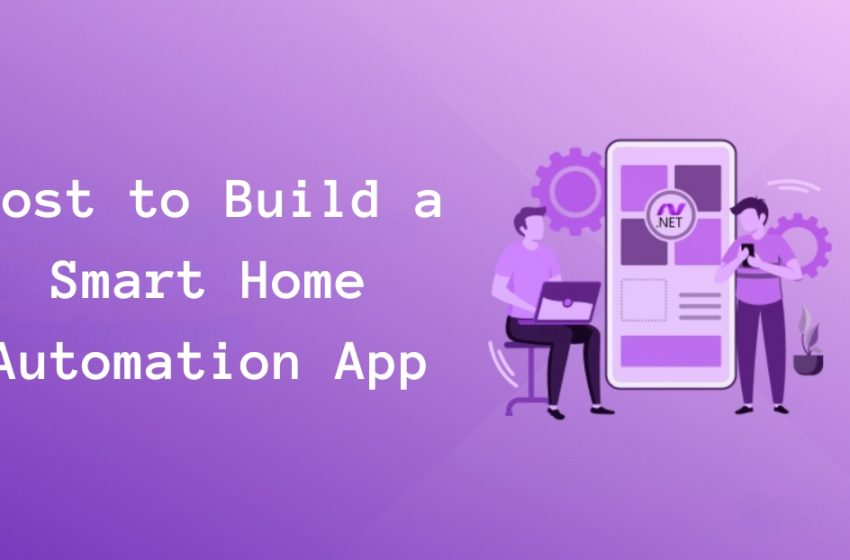What is the Cost to Build a Smart Home Automation App

Whenever we hear the term “smart home”, one thing pops in our mind is “Modern Living” with a plethora of possibilities to make our life easy. From adjusting the thermostat to turning off lights remotely, these smart home automation apps use IoT to create a smart home environment.
The worldwide smart home market was valued at USD 80.45 billion in 2022. It’s predicted to reach USD 581.85 billion by 2032, with a CAGR of 21.88%.
If you are planning to build a smart home automation app, it’s essential to have an idea about the smart home automation app development cost. In this blog, we will explore the cost to build a smart home automation app and factors to determine the exact cost.
Factors Impacts A Smart Home Automation App Development Cost
Features Complexity
The complex features significantly influence the mobile app development cost. Basic functionalities like controlling lights, thermostats, and security cameras will incur lower costs compared to advanced features such as AI-driven automation, voice commands, and remote monitoring of energy consumption. The more intricate the features, the higher the development cost.
Essential smart home automation apps with limited features may cost anywhere from $10,000 to $50,000 to develop. More advanced apps with AI-driven automation, voice control, and extensive device integration can range from $50,000 to $200,000 or more.
Platforms
The choice of platforms—whether developing for iOS, Android, or both—affects the cost.
Cost to build a smart home automation app for a single platform can range between $20,000 and $50,000. On the other hand, cross-platform development may require budget range from $50,000 to $100,000 or more.
Impressive UI/UX Design
A well-designed UI/UX plays a vital role in the success of a smart home automation app. Investing in intuitive navigation, responsive design, and visually appealing interfaces not only increases user satisfaction but also increases development cost.
Design costs can range from U.S. $5,000 to U.S. $30,000 based on the design complexity and customizations requirements.
Integration with Hardware & APIs
Automation apps for smart homes depend on seamless integration of technologies with various hardware devices and external APIs to control and communicate with smart devices.
Hardware integration and API development costs can range from U.S. $10,000 to U.S. $50,000 or more, based on device types and numbers and APIs.
Security and Data Privacy
When it comes to protecting user data against cyber threats, security plays a vital role in smart home app development.
Compliance with data regulations such as GDPR or CCPA may require additional resources, influencing overall costs of smart home automation mobile app development.
Development Team Location
Smart home automation app development costs depend on the location and expertise of the development team. Hiring experienced developers with in-depth knowledge and experience in the same domain may require higher costs but can ensure quality results.
Cost to build smart home app may differ significantly between regions because of labor prices, infrastructure and market demand.
Development services can range from $50 to $200 hourly rates or more based on the team’s location and expertise.
How to Develop a Smart Home Automation App?
Here are the most important steps you need to follow to build a smart home automation app:
Research Your Market & Objectives
Identify objectives, the target audience and their needs before building your smart home automation app. Conduct market research to understand your requirements and build satisfied and innovative apps.
Select the Right Platform
Ensure you build the app for a specific platform such as Android, iOS or choose for cross-platform development. Before making any decisions regarding platform, consider these factors such as target audience, demographics, market share and development resources.
Design Interactive UI and UX
Design an intuitive and user-friendly UI/UX design that enables seamless interaction with the app’s features and functionalities. Consider layout, navigation, visual elements, and consistency across several devices. Focus on simplicity and accessibility to improve the user experience.
Identify Key Features
Determine the essential features and functionalities your smart home automation app will offer. This may include device control (e.g., lights, thermostats, locks), scheduling and automation, energy monitoring, security alerts, remote access, and integration with third-party services or platforms (e.g., voice assistants).
Select Integration Tools & Technologies
Select the appropriate technologies and communication protocols to integrate with smart home devices and systems. Standard protocols include Wi-Fi, Bluetooth, Zigbee, Z-Wave, and MQTT. Ensure compatibility with a wide range of devices to maximize the app’s utility and appeal to users.
Develop Backend Infrastructure
From user authentication and data storage to device management and communication with external APIs, you can support app’s functionality by building strong backend infrastructure. Consider reliability, safety and scalability for designing and developing the backend architecture.
Integrate Security Measures
Protect your user’s data from potential threats by using security stage during app development method. Integration, encryption and authentication process helps to mitigate risks and ensure user privacy.
Test Software
Identify any bugs, performance issues, or usability concerns through testing stage. Test & iterate apps on several devices, operating systems, and networks for higher compatibility and reliability.
Continuous Deployment
Deploy the smart home automation mobile app to the app stores (e.g., Apple App Store, Google Play Store).
Monitor app performance, user feedback, and data analytics to identify areas for improvement and updates. Continuously iterate and improve the app based on market trends.
Provide Ongoing Support and Maintenance
Ongoing support and maintenance to ensure the app remains secure and updated. Identify user inquiries, resolve any issues and launch regular updates with new features, & improvements.
The Final Thought!
The factors mentioned above will help you determine the exact cost of smart home automation app development for Android or iOS platforms. If you want to build automation for smart homes, contact a dedicated IoT app development company like VLink. They will help you turn your idea into a successful smart home automation software.

